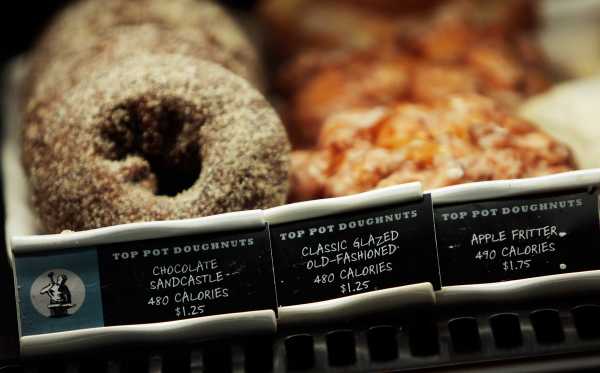
It’s finally happening. After nearly a decade of delays, the Food and Drug Administration is implementing an Obama-era policy on Monday that will require restaurants and other food outlets with 20 or more locations to post calorie counts.
Any big chain — from grocery stores to movie theaters, amusement parks to vending machines to restaurants — will have to show how many calories come with their sandwiches, popcorn, cocktails, and french fries. Up front. Right on the menus.
In some eateries, menu labeling is already happening. Several major chains started to move in this direction because the FDA was expected to finalize this regulation years ago. It’s why you can see that the grande latte at Starbucks has 190 calories, the turkey, apple, and cheddar sandwich at Panera has 710 calories, and McDonald’s Big Mac packs 530 calories, for example.
But we’ll now be saturated in calorie data — everywhere. And while these changes aren’t expected to cause Americans to suddenly clean up their diets, they could have profound indirect effects on how we think about food and nutrition, what we choose from the menu, and ultimately what restaurants serve.
We now get most of our calories from eating out — but it’s been hard to know what we are eating
Americans do a lot of their eating outside of the home these days. More than half of the money spent on food goes to restaurants and convenient on-the-go meals — not to groceries cooked at home.
Make no mistake: When we dine out, we eat more. People typically consume 20 to 40 percent more calories in restaurants compared with what they’d eat at home.
As Tuft University researchers found, in the Journal of the Academy of Nutrition and Dietetics, restaurant dishes at non-chain establishments across the country typically contained 1,200 calories — about half of the 2,000 or 2,500 calories recommended for moderately active women and men in an entire day. For these reasons, the American propensity to dine out has been linked with the obesity epidemic.
For a long time, consumers were left to operate blindly when it came to how many calories they were consuming when dining out. Unlike the nutrition facts panels that come with preprepared foods we eat at home, there was no such transparency around restaurant food.
Then along came the Affordable Care Act in 2010. Buried among its many provisions were rules requiring “retail food establishments” with 20 or more locations to post “on the menu listing the item for sale, the number of calories contained in the standard menu item,” as Vox’s Sarah Kliff reported. Another section in the law mandated vending machines “provide a sign in close proximity to each article of food or the selection button that includes a clear and conspicuous statement disclosing the number of calories contained in the article.”
The hope was that these regulations would help people calculate how many calories they were eating, and maybe have an impact on obesity.
“Big Pizza” and other food lobby groups tried to fight menu labeling. Then the FDA’s commissioner said he’d get the job done.
The Food and Drug Administration, which regulates the food industry, was in charge of finalizing and implementing menu labeling. But the Obamacare mandates, even under President Barack Obama, were beset by delays because of intense lobbying from various factions of the food industry.
American pizza makers have pushed for, among other things, only posting calories for serving sizes they determine, instead of the actual serving sizes people are going to eat. Convenience stores and supermarkets argued menu labeling, while appropriate for restaurants, would be too expensive and burdensome for them. Movie theaters, for their part, tried to keep their 1,000-calorie popcorns out of the calorie postings.
Finally, in November 2017, the FDA released draft guidance about how the industry would have to comply with the menu labeling by May 2018. Health advocates said they were pleased to see the rule was left mostly intact, which came as a surprise since the Trump administration had pushed back the implementation of the rule just before it was supposed to go into effect a year ago, last May.
The FDA Commissioner Scott Gottlieb has repeatedly pledged his personal interest in nutrition and going ahead with menu labeling, as Politico’s Helena Bottemiller Evich reported. For that reason, the Center for Science in the Public Interest, which had sued the FDA over menu labeling delays, put their lawsuit on hold in September.
For now, it seems Gottlieb has kept his word. In a May 2 blog post, he framed the regulation as a win for consumers and a way to enhance competition among food producers to create products that are “healthy, inexpensive … [and] also tasteful.”
“I’ve working on menu labeling for 15 years, and am thrilled that at long last, people will be able make up their own mind about how many calories they want to eat at chain restaurants,” said Margo Wootan, director of nutrition policy at the Center for Science in the Public Interest. “Menu labeling allows people an easy way to cut hundreds of calories or more with simple, split-second decisions.”
The law could have a far-reaching impact, and not just on the food choices individuals make
To date, the evidence on calorie labeling’s impact on health is somewhat mixed. The studies and meta-analyses either suggest that calorie labeling has had little influence over people’s food choices or that the available studies are too poorly designed to really tell. A newer Cochrane Review also concluded that the quality of the available evidence is low — but noted some studies suggesting labeling may reduce calorie intake by about 50 calories per meal (or 8 percent of a 600 calorie meal).
Researchers have also found that people who are already calorie-conscious do pay attention to labels, but those who aren’t don’t. In other words, just having that information displayed doesn’t intrinsically change people’s behaviors. So health wonks don’t expect most people will immediately start making healthier food choices when menu labels come out.
But calorie labeling is expected to do two other things: push food companies and restaurants to reformulate products so that they aren’t so hideously high in calories, and change consumer attitudes about nutrition, maybe getting people to cut a few calories out of their diets.
Researchers have found that after a menu labeling was implemented in Seattle in 2009, food purveyors tweaked their recipes and lowered calories, for example.
Menu labeling also prompts people to talk about calories in foods — raising awareness about nutrition, as this Health Affairs study pointed out:
Harvard Medical School researcher Jason Block, who has been studying calorie labeling, draws a comparison to how smoking behaviors have evolved over time. “The story about tobacco policies and how smoking patterns have changed is as much a story about changing social norms as it is about specific policies. This widespread implementation of a public education campaign like calorie labeling should change the public’s consciousness about calories.”
We know from the soda tax debate that it’s been hard to disentangle what impact the taxes are having from the awareness the tax debate raised about the health impact of soda. The same may be true about calorie labeling — and perhaps that means that all the discussion about this Obama-era mandate and the years of news articles about delays in the press means it’s already having an effect.
Sourse: vox.com






